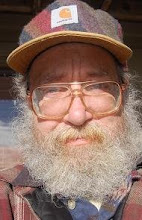Okay, it's pretty tiny, but there's a lot going on here. (
Right-click the image here for size options.)
(
size options) We're looking roughly NW to SW here. Starting from the north (right), I've labeled Fish Lake, a seasonal impoundment. By mid to late summer, it's a basically dry field. But during melt season, water coming down from the Western Cascades ponds up here, and if flow is especially strong, can actually make it across the young lava flows to Clear Lake, overland. Most of the contained water, though, works its way into the rubble and travels as groundwater to the same destination. A similar spot is Lava Lake, out of the photo to the left, or hidden behind the trees or crater rim.
Iron Mountain is just above Tombstone Pass, where US Route 20 crests the Western Cascades. I have the sense it's an old volcanic neck, though I've never really gone up and looked at it. It's best known as a magnificent hike for wildflowers in the late spring to mid summer. 20 comes down the valley above Fish Lake, and comes to McKenzie Junction a few miles north of that spot. We could pick out its line through the trees while we were up there, but I'm not seeing it in this photo.
Next South is Clear Lake, the source of the McKenzie. Except during highest flow conditions, essentially all the water there is emerging from springs in the lake. It's pretty mind-blowing to realize that the vast bulk of the precipitation in the basin around and to the north of Clear lake simply goes underground, to re-emerge there, unseen, and basically invisible. The river is surprisingly powerful when it emerges from the lake.
Though I only labeled the Sand Mountain crater rim about halfway across the photo, I hope it's clear that it covers the full extent of the bottom portion.
The McKenzie drainage, like the Willamette drainage, is first and foremost structurally controlled. That is, those rivers are where they are due to the geologic structure of their basins, not because they simply happened to carve a valley there. So the McKenzie River is contiguous with the western half of the High Cascades graben. Green Ridge, which can just be seen peeking out between Black Butte and Hayrick Butte in Monday's panorama, is the eastern half. I think this is the first time I've been able to see both from one spot.
Finally, marked with a dotted line, you can see the spot where the Upper McKenzie River, flowing basically north to south, turns abruptly west to flow down toward Eugene. Route 242, which wends its way up to McKenzie Pass, takes off at about that point. I made the line dotted because, while you can clearly see the upper reaches of that valley, the river itself is immediately hidden behind the ridge.
I don't know if I'll do this hike again. It would have been trivial when I was in my 20's and 30's- only four miles round trip, with maybe
500-600 800 feet elevation gain. But Tuesday and yesterday I was darned near crippled from my achy legs, and while less stiff today, they're still sore. On the the other hand, was it worth it? Oh, my, yes!
Photo unmodified. August 11, 2013.
FlashEarth location.










